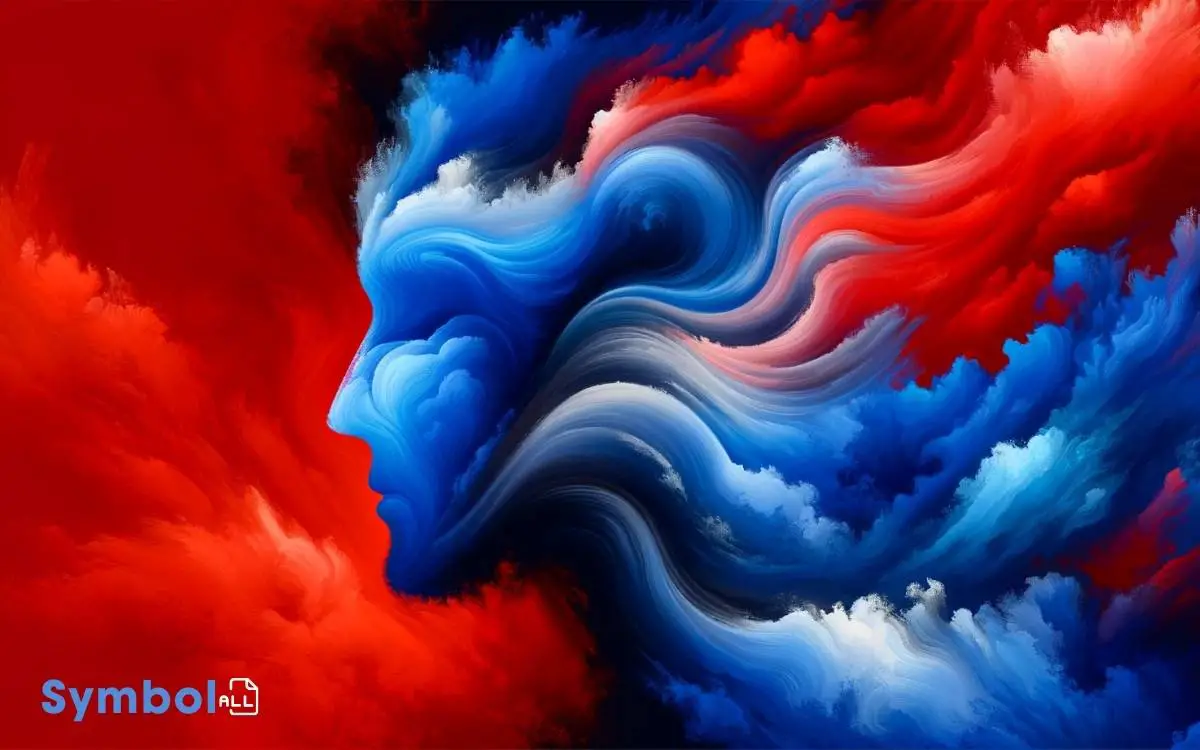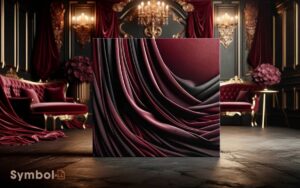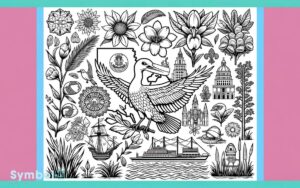What Do the Colors Red and Blue Symbolize? Power, Trust!
You’ll discover that red symbolizes power, passion, and danger, resonating deeply from ancient elite symbols to modern expressions of strength and love.
In contrast, blue represents tranquility, trust, and creativity, serving as a calming force and symbol of loyalty across cultures. While red evokes intense emotions of love and aggression, blue brings peace and stimulates innovation.
Both colors have been significant through history, in religious practices, and fashion, carrying meanings of luxury, reliability, and spiritual depth.
Their symbolism stretches from political power to enhancing well-being, offering a rich tapestry of meanings that unfolds with further exploration.

Key Takeaways
Historical Significance of Red
Throughout history, red has symbolized power, passion, and danger across various cultures, often reflecting the intensity of human emotions and the natural world’s dynamism.
You’ll find that red’s historical significance isn’t merely accidental. It’s deeply rooted in its visibility and rarity, making it a coveted symbol of status and significance.
In ancient times, red pigments were difficult to produce, reserving their use for the elite and for significant occasions. This exclusivity amplified its association with power.
Additionally, the color’s visibility meant it could communicate messages vividly across distances, making it indispensable in rituals and warfare.
Analyzing red’s historical context reveals its multifaceted role in human society, embodying both the heights of power and the depths of danger, encapsulating the complex spectrum of human experience.
Cultural Interpretations of Red
Building on its historical significance, red’s cultural interpretations vary widely, reflecting diverse societal values and beliefs.
In China, it’s the color of luck, prosperity, and joy, often used in festivals and weddings to invite fortune and fend off evil spirits.
Conversely, in some African cultures, red symbolizes death and mourning, showing the depth of loss.
In the political arena, red can signify revolution and power, a call to action that has rallied individuals around the globe.
Yet, among indigenous American tribes, red stands as a sacred color, embodying the earth, its people, and their connection to spirituality.
Each interpretation offers a glimpse into how societies use color to communicate their most profound aspirations and fears, making red not just a color but a language understood across cultural boundaries.
Emotional Impact of Red
Evoking strong emotions, red often influences your feelings, sometimes without you even realizing it, across various cultures and contexts. It’s a color that can signal both danger and passion, a dual nature that speaks to its powerful psychological impact.
In many cultures, red is associated with love, warmth, and comfort, drawing you closer and creating a sense of intimacy. Conversely, it can also incite feelings of aggression or provoke a sense of urgency, making your heart race and your adrenaline surge.
This emotional versatility means that red carries different meanings and evokes varied responses depending on its use and interpretation. Whether in art, nature, or symbolism, red’s emotional impact is undeniable, shaping your reactions and perceptions in profound ways.
Red in Modern Fashion
How does the color red weave its way through the fabric of modern fashion, influencing trends and consumer decisions across cultures?
In today’s global fashion scene, red stands as a powerful emblem of passion, energy, and boldness. Designers across the world harness its intensity to create statements that traverse cultural boundaries.
You’ll find red in everything from the haute couture runways of Paris to the street styles of Tokyo, where it often symbolizes strength, luxury, and a fearless attitude towards self-expression.
Additionally, red’s adaptability means it’s as likely to be seen in everyday wear as it’s in avant-garde pieces, allowing individuals to incorporate this vibrant color into their personal style, regardless of the occasion.
Red’s universal appeal guarantees its enduring presence in the fashion world, continually inspiring designers and enchanting consumers.
Historical Significance of Blue
As you explore the historical significance of blue, you’ll find its roots deeply embedded in ancient civilizations, where it symbolized both the divine and the earthly.
This color’s journey through time reveals its evolution into a status symbol for royalty, highlighting its exclusivity and power across cultures.
Moreover, blue’s religious associations underscore its profound impact on spiritual practices and iconography worldwide, reflecting a rich tapestry of beliefs and values.
Blue in Ancient Civilizations
In ancient civilizations, the color blue held profound significance, manifesting in art, architecture, and religious practices across various cultures. You’ll find that each society attributed unique meanings to blue, deeply woven into their cultural fabric.
| Civilization | Significance of Blue |
|---|---|
| Egypt | Symbolized the Nile, the sky, and the gods, indicating life and rebirth. |
| Mesopotamia | Associated with the Euphrates River and divinity, signifying water and power. |
| China | Represented immortality and the Taoist heavens, embodying harmony and tranquility. |
| Greece | Linked to the skies and the seas, denoting distance, the divine, and the unknown. |
This cross-cultural reverence for blue underlines its universal appeal and the profound emotional and spiritual responses it elicited in ancient societies.
Royal Blue: A Status Symbol
Building on the rich tapestry of meanings attributed to blue in ancient civilizations, it’s fascinating to explore its evolution to a symbol of power and status, particularly in the form of royal blue.
This deep, vibrant shade has long been associated with nobility, signifying not just wealth, but a distinguished lineage and authority.
Across different cultures, royal blue holds a unique place in the social hierarchy, reflecting its enduring allure and significance.
- Exclusivity in Production: Historically, the dyes used to create royal blue were rare and expensive, making garments of this color exclusive to the elite.
- Symbolic Representation: Royal blue represents wisdom, trust, and loyalty, qualities befitting a ruler or leader.
- Cross-Cultural Significance: From European monarchies to Eastern dynasties, royal blue has been a universal marker of rank and privilege.
Blues Religious Associations
Exploring the historical significance of blue unveils its spiritual and religious associations, which are as vivid and deep as the color itself. These connections span various cultures and epochs, showcasing blue’s enduring importance.
In Christianity, blue is often linked with the Virgin Mary, symbolizing truth and heavenly grace. This association reflects the color’s spiritual symbolism within the Christian faith.
In Hinduism, blue holds significance as the color of Krishna, representing divine joy and love. This association underscores blue’s role in expressing sacred emotions and connections within Hindu beliefs.
Islam also honors blue for its representation of immortality and spirituality, evident in the intricate mosaics adorning mosques. This reverence for blue reflects its enduring presence in Islamic art and culture.
Even in ancient Egypt, blue was tied to the sky and the gods, embodying themes of creation and rebirth. This ancient connection underscores blue’s enduring symbolic power across diverse civilizations and time periods.
Cultural Interpretations of Blue
You’ll discover that blue, as a color, carries diverse meanings across cultures, reflecting a range of emotions, beliefs, and values. Its significance varies widely, providing a fascinating glimpse into how colors shape our perception and understanding of the world around us.
- In Japan, blue often symbolizes coolness and calm, embodying both physical and spiritual tranquility.
- Among the Tuareg people of the Sahara, men wear indigo veils signifying wisdom and nobility, with the dye believed to protect the skin and soul.
- In Western cultures, blue is frequently associated with trustworthiness and stability, hence its prevalent use in corporate logos and uniforms.
This cross-cultural analysis of blue reveals its multifaceted character, bridging gaps between diverse societal norms and practices.
Emotional Impact of Blue
As you explore the emotional impact of blue across cultures, you’ll find its calming influence is nearly universal, offering a serene backdrop to our hectic lives.
This color’s perception as trustworthy varies from one society to another, reflecting deep-seated cultural narratives and values.
Surprisingly, blue’s ability to enhance creativity suggests a complex psychological underpinning, encouraging you to contemplate how color influences cognitive processes globally.
Calming Influence of Blue
The color blue often exerts a calming influence across various cultures, soothing emotions and lowering stress levels in individuals.
This universal appeal of blue stems from its association with elements of nature, such as the sky and the ocean, which are often perceived as vast and tranquil spaces.
The emotional impact of blue is significant, playing a key role in creating environments that promote relaxation and mental clarity.
- Nature’s Palette: Blue’s connection to clear skies and calm waters contributes to its soothing effects.
- Cross-Cultural Serenity: Across different cultures, blue is consistently associated with tranquility and peace.
- Psychological Effects: Studies suggest that exposure to blue can reduce anxiety and increase feelings of well-being.
Understanding the calming influence of blue can help you harness its benefits, whether you’re choosing a color for your home or selecting an outfit to wear.
Blues Trustworthiness Perception
Building on blue’s serene qualities, it’s also perceived globally as a symbol of trustworthiness, influencing emotions and decisions in a variety of contexts.
This universal perception isn’t arbitrary; it’s deeply rooted in cultural narratives and psychological associations that span across societies.
In corporate branding, for example, blue is often employed to evoke a sense of reliability and confidence in the consumer. Financial institutions, tech companies, and healthcare services frequently use blue in their logos to project security and stability.
This strategic choice taps into the collective unconscious, where blue is aligned with loyalty, wisdom, and faith.
Across different cultures, this color maintains a consistent message of trust, making it a powerful tool in communication and branding strategies.
Its impact on perception underscores the importance of color psychology in shaping our understanding and trust in the world around us.
Creativity Boost With Blue
Delving into the emotional impact of blue, research reveals it doesn’t just evoke tranquility but also greatly boosts creativity across cultures.
This hue’s association with openness and peace facilitates a mental state where your mind can wander freely, making connections that mightn’t be obvious at first glance. It’s fascinating how this color can influence cognitive functions so profoundly.
- Encourages Risk-Taking: Studies suggest that people are more likely to explore unknown options in a blue environment.
- Enhances Problem-Solving: Being surrounded by blue can improve your ability to tackle complex problems creatively.
- Broadens Perspective: Blue seems to help in looking beyond the obvious, encouraging innovative thoughts.
Understanding blue’s capability to enhance creativity can be a powerful tool in various fields, from design to education, fostering environments that encourage novel ideas and solutions.
Blue in Modern Fashion
In modern fashion, blue has emerged as a universal color, symbolizing a range of emotions and ideas across different cultures, while maintaining its appeal through various styles and trends. It’s a color that carries the weight of tradition and innovation equally on its shoulders.
In the West, blue’s association with calmness and stability makes it a staple in business attire, promoting a sense of trust and reliability.
Meanwhile, in Eastern cultures, blue often conveys immortality and spirituality, weaving into traditional garments with a deeper, symbolic resonance.
Its versatility is unmatched, seamlessly shifting from the casual comfort of denim to the opulent sophistication of evening wear.
Fashion designers across the globe leverage blue’s broad spectrum to evoke feelings, tell stories, and bridge cultural divides, making it a truly global icon in the fashion industry.
Conclusion
As you’ve journeyed through the tapestry of red and blue, you’ve seen how these colors paint our world with emotions, culture, and history.
Red, like a fiery heartbeat, pulses with passion and power, while blue, the calm in every storm, offers a soothing embrace of tranquility.
Both hues, woven into the fabric of modern fashion, reflect humanity’s diverse expressions. Across cultures, they serve as a universal language, speaking to our shared experiences and the depth of our emotional landscapes.






